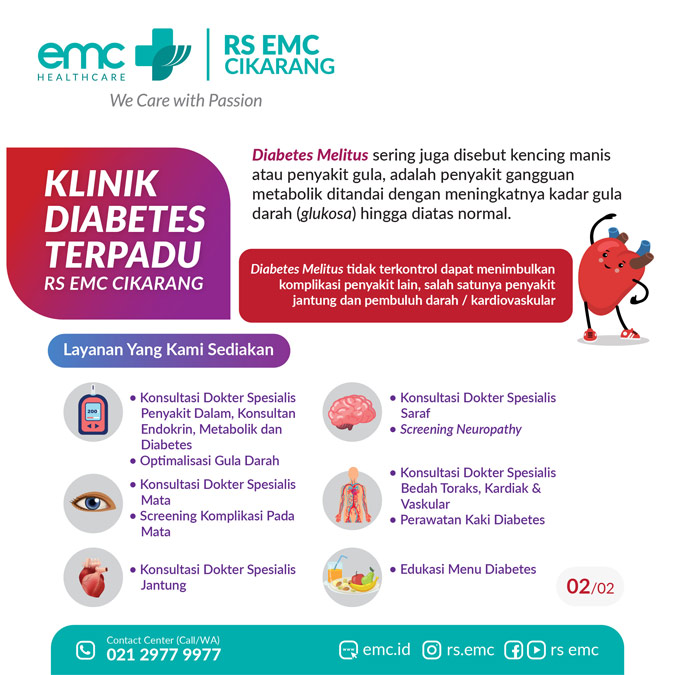
(21/09/2022) EMC Cikarang Hospital officially opened the Integrated Diabetes Clinic. In his remarks, the Director of EMC Cikarang Hospital, dr. Rudy Susanto, BS-BIO conveyed the aim of inaugurating the Integrated Diabetes Clinic to fulfill the EMC Healthcare vision, to become one of the excellent and trusted health service providers for all levels of the community, prior to advancing the quality of health services in Indonesia.
Hoping that this Diabetes Clinic can help treat patients with diabetes, especially for the people of the Cikarang area and its surroundings, as they are no longer required to go far just for treatment, because this integrated service is one of the highlights in Cikarang, Bekasi city.

At the inauguration of the Integrated Diabetes Clinic at EMC Cikarang Hospital, a talk show was also held to introduce the specialist doctors in the industry such as dr. Yosephine, Sp –PD-KEMD ( Internist Specialist - Metabolic, Endocrine & Diabetes Consultant), dr. Marolop Pardede, Sp, BTKV (K), MH ( Thoracic, Cardiac and Vascular Surgery), and dr. Irene Halim Subrata, Sp. N (Neurology / Nerve Specialist).
In cases of diabetes, it is usually associated with blockage of blood vessels, especially arteries, also known as Peripheral Arterial Disease (PAD). PAD is a disease of the arteries caused by blockages (atherosclerosis), and diabetes mellitus is a high-risk factor for this disease.
“Diabetes mellitus patients are at risk of developing PAD 20 times greater than non-diabetic Mellitus patients. The possibility of an amputation also increases if PAD occurs by 34.1% and mortality is 5.5%," said dr. Yosephine, Sp –PD-KEMD
The symptoms in patients with diabetic wounds are accompanied by blood vessel disorders in the form of wounds that do not heal (chronic), and wounds that smell and emit pus, to black. Comprehensive and consistent examinations are needed so that people with diabetic wounds can be treated as early as possible so as to prevent amputation.
“With the development of medical science, especially in the field of blood vessels, we can open blood vessels with stents or balloons, so that the incidence of amputation can be reduced. Some of the problems that occur in diabetic wounds, especially on the feet, are reduced to the loss of sensation in the feet. This causes sufferers not to feel pain when their feet are injured," he said
Diabetes Mellitus is a metabolic disease characterized by increased blood sugar levels caused by reduced insulin levels or reduced insulin sensitivity that interferes with the function of insulin.
“Diabetic wounds or feet are most often found in patients with uncontrolled Diabetes Mellitus. Wounds in patients with Diabetes Mellitus can occur due to the formation of thrombus plaques in the arteries which can be called atherosclerosis. Wounds in diabetes often occur in the lower extremities," said Dr. Marolop Pardede, Sp, BTKV (K), MH.
Atherosclerosis that occurs in diabetic feet also causes blood vessel disorders, thereby increasing the risk of infection, and causes wounds on the feet to be difficult to heal so that they become necrosis and gangrene, which result in a body tissue dying and turning black due to lack of blood flow but can still be treated routinely.

